COVID-19 2020: America is in a tailspin. Beyond demands for toilet paper, hand sanitizer, and masks, the pandemic is pushing gun sales. The latter is a whole new world for some. Others will be shopping for a practical firearm that fills a niche. Safe bet security will be a main drive for all. For some, interests could extend to subsistence capabilities. Suddenly, self-reliance matters in the world of practical long guns for preppers.
by Steve Markwith
If you haven’t already, see my Starting a Survival Gun Collection for information regarding my survival-based firearm criteria. In a nutshell, reliability, simplified maintenance, and availability of parts counted heavily. So did well-established designs. Even the big-name manufacturers have launched an occasional dud, so firearms with lengthy track records got the nod. An abundance of accessories (sometimes even clones) is a good indicator of successful designs. This has a positive effect on logistics, including availability of critical parts. Availability of ammunition is equally important. The recent .45 GAP got plenty of early attention, but it’s now pretty much a memory. Given the increasing strangulation of supply lines, domestic (U.S.) production also counts heavily.
Those that make the list involve firsthand experience with several specimens – or more (sometimes hundreds of ‘em). Please consider this post a menu. The idea is NOT to buy ‘em all! Instead pick and choose to fit your circumstances. For some, hunting will be important. Others may center strictly on defense, (hopefully) with a provision for practice. Either way, you’ll find viable choices. And, let’s not forget about the fun-factor. Plinking cans or steel auto resetting spinners can be highly entertaining, with a bonus of sharpened skills.
Since some new purchases from the influx of new (or repeat) buyers will involve “household” guns, shared use is factored when including considerations for left-handed (LH) users. A disappointment for some: CDI doesn’t count. That stands for Chicks Dig It (even though most won’t).
Otherwise known as the cool factor, it typically involves Ninja-looking AR or AK blasters, equipped with numerous extraneous items guaranteed to break or fall off when the going gets tough. Priority one, it’s gotta work. Quite often, simple is better.
Along that vein, let’s look at practical long guns. Yes, handguns are extremely useful and attract much less attention, but they’re not a good choice for subsistence purposes. With social interaction and basic commodities curtailed, repelling boarders or providing food are greater concerns. So, first up is one extremely useful tool that can meet these requirements without draining available funds.
NUMBER ONE – A Slide-Action Shotgun
I’ll take a plain old 12 Gauge Remington Model 870 pump. Honestly, it’ll do just about everything. It’s also been around since 1950 and millions have been sold. I inventoried dozens of ‘em configured as “Police” models with 21” barrels and iron sights. Problems were rare although we fired literally tons of feisty 2 ¾” buckshot and slugs for years. Even plain old Winchester 2 ¾” Super-X slugs routinely grouped into three-inches or less at 50 yards.
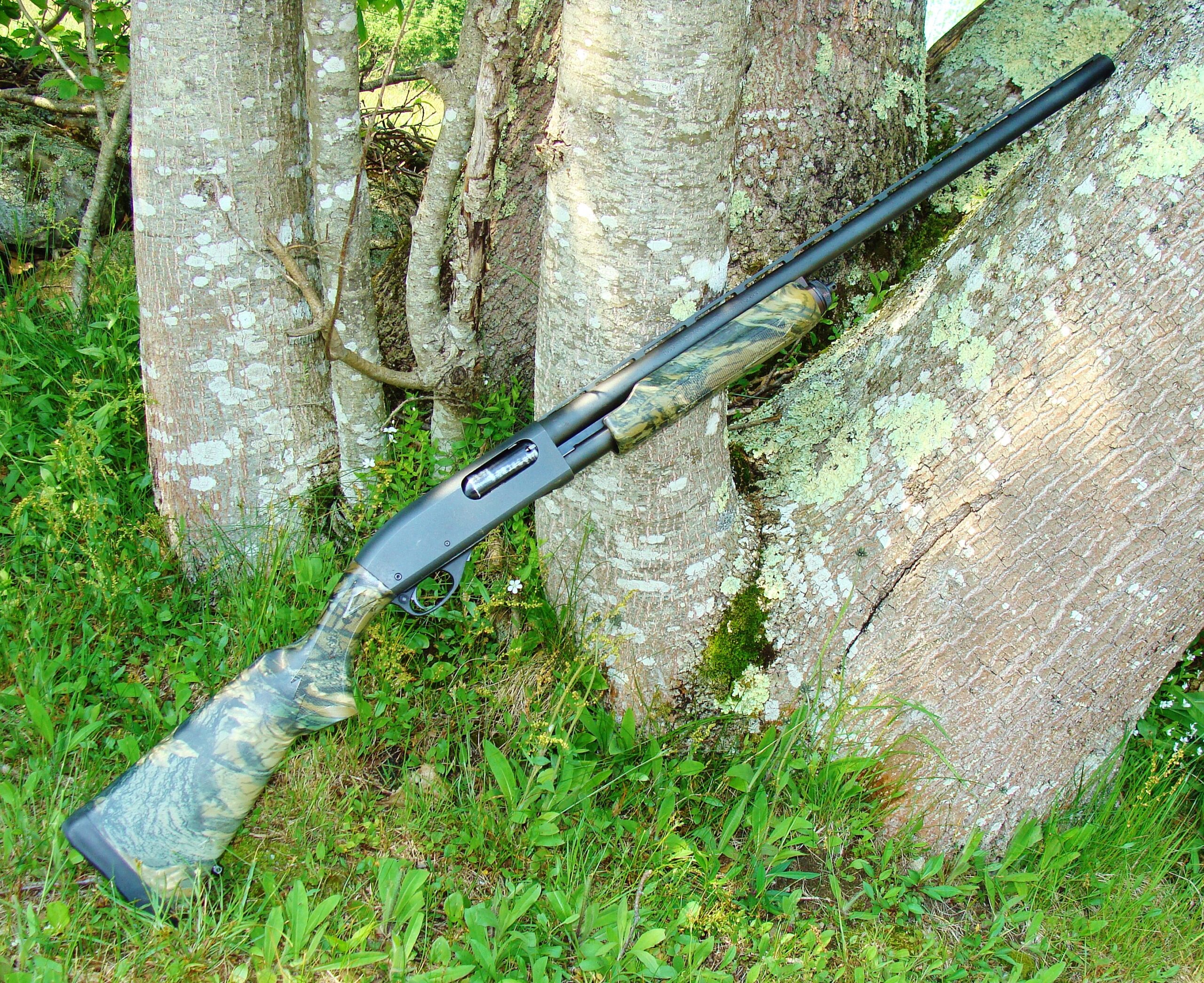
These big .73-caliber bullets will hammer any two or four-legged threats out to 100 yards (even further with some specialty options). Beyond serving as a rifle, you’ll also gain a serious defensive tool capable of firing numerous multiple-projectiles, including common 00 Buck shells, which spit out nine .33-caliber pellets per pop. Beyond birds or small game, don’t rule out birdshot (like #6s) for use in confined spaces.
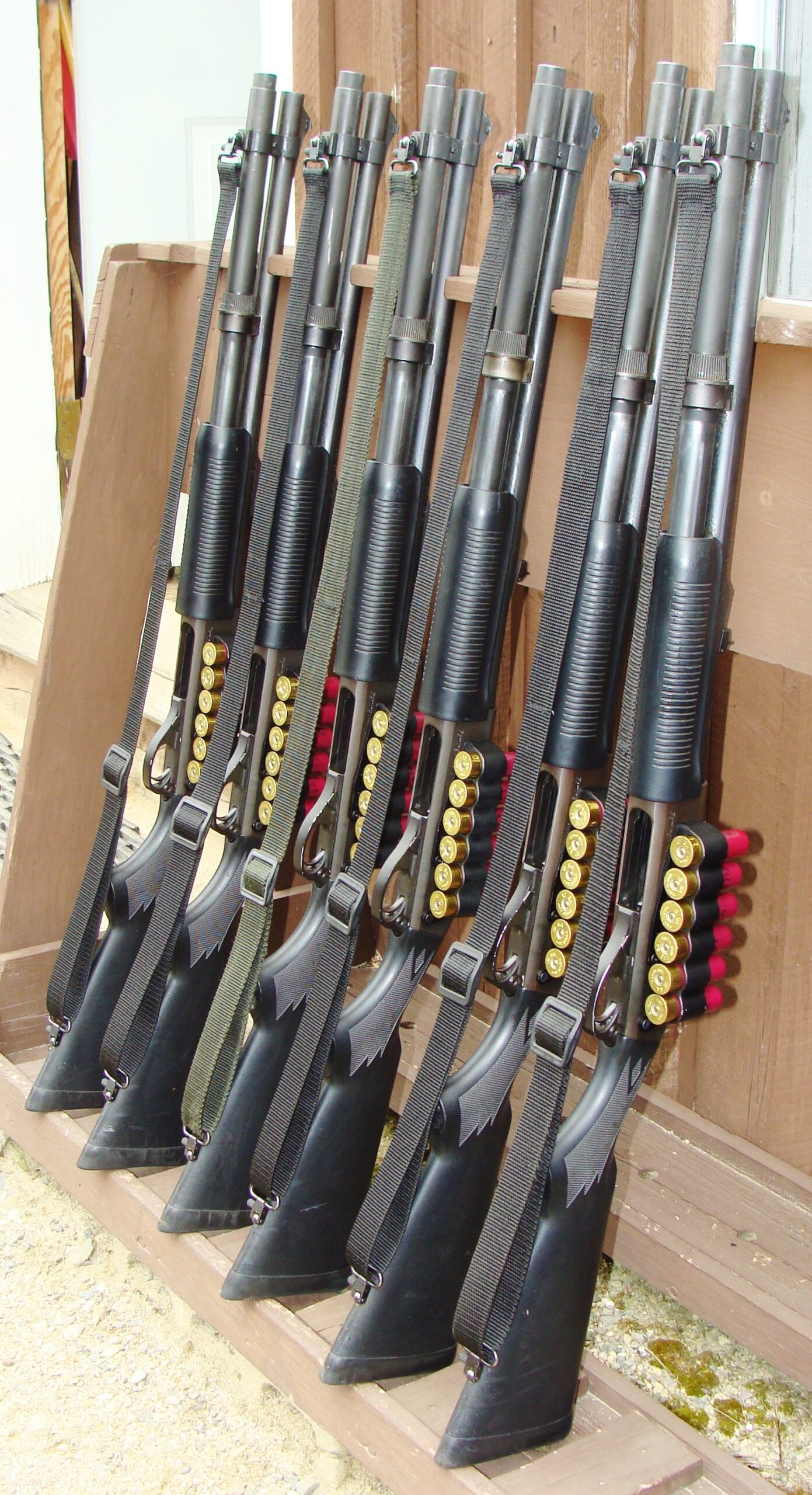
I really like semi-autos but a manually-operated pump-gun will digest everything, including specialty “less lethal” rounds. More relevant to most, if kick is a problem, “low recoil” loads will function fine. Another option is smaller 20 gauge youth/ladies version. Back to that 12 gauge 21” iron-sighted gun; add a 28” Rem Choke bird barrel and you can fill your freezer with shotgun-only species including upland birds, waterfowl, and turkeys. Accessories abound but a basic gun will do.
Read: Shotguns a Comprehensive Guide by Steve Markwith
The “Express” models are affordable. Although not available in stainless, their matte, bead-blasted finishes hold oil quite well and the synthetic-stock models are weatherproof. I’d skip the latest detachable-magazine versions, along with the new shotgun/banana thingies that look cool. A solid gun mount is the key to a fast and accurate response with much more control for follow-up shots.
This counts for hunting as well as defense. We added magazine extensions to our LE 870s, which boosted capacity to 7 +1. Mesa receiver-mounted side-saddles (aluminum to prevent breakage in cold weather) added 6 additional shells. The result was a grab & go package that weighed a ton and complicated barrel removal. Life is much simpler with the standard 4 +1 design. Within seconds you can spin off the magazine cap, pull the barrel, and install a new one.
Advantages
Pumps are legal everywhere, costs are reasonable, and the standard tubular magazine types are entirely self-contained. Extra barrels are easy to install. Disassembly is simple. LH versions are available (although an 870’s safety is easily reversible). You won’t find a more versatile system. The mere act of racking its slide is a serious attention-getter. The business end is large and whoop-ass scary.
Disadvantages
Recoil, which can be managed through gauges and loads. Supposedly, limited range and capacity. But slugs can easily cover 100 yards and, with training, you can sustain-load a tubular magazine to stay in a fight. Ammo weight is more of an issue, but spare bandoleers can be stashed in a pack.
Alternative choice: A similarly configured Mossberg, which also enjoys a solid reputation. It can be adapted to feed new mini-shells, permitting extra bang per pound. Also, its tang-mounted safety supports ambidextrous operation. The Mossberg received minimal attention here only due to limited personal experience.
NUMBER TWO – The Iconic .22 LR Semi-Automatic Rifle
The Ruger 10/22 is an enormously popular design which now extends to copies. A basic Ruger begins at around $250, increasing from there via extra features. However, even a plain version can be completely tricked out. Parts and a dazzling array of accessories are available for user customization. As for the ubiquitous .22 LR chambering, beyond affordable ammo, the report is relatively mild; perfect for practice and hunting small game. Although it’s fun to develop a custom rifle, once again, the basic 10/22 will work. Just add a basic 1” diameter rimfire scope in 4X, 2-7X, or 3-9X. Ruger’s takedown model will appeal to many. It offers QD barrel separation and repeatable zero in a useful bug-out package.

Advantages
It’s legal just about everywhere, and innocuous in basic form. Those that get the itch can always add extras incrementally. Disassembly for cleaning is fairly simple. Spare 10-round (or greater) magazines are readily available, and easy to carry for quick reloads. Although a .22 is far from an ideal defensive choice, getting peppered by a blizzard of high-speed HPs could ruin someone’s day.
Disadvantages
No last-shot hold-open for the Ruger version (although the bolt can be manually locked open). And, low-powered quiet loads won’t function unless single-loaded, which can be a nuisance. However CCI .22 LR “Quiets” will feed by manually cycling the bolt, and their latest semiauto CCI Quiets may even cycle. No LH provisions, but the design is still entirely useable.
NUMBER THREE – A Bolt-Action .22 Rifle
A bolt-action .22 rifle that can fire .22 Shorts, Longs, or Long Rifle cartridges can perform some neat tricks. My beater circa 1960 Remington single-shot M-510 Scoremaster is a snap to load and shoots everything well. For pest control, all sorts of interesting options are available, including rat shot, ultra-quiet.22 Shorts, and CB Caps. Thus, it could also stand in for an air rifle – or for clandestine subsistence purposes.
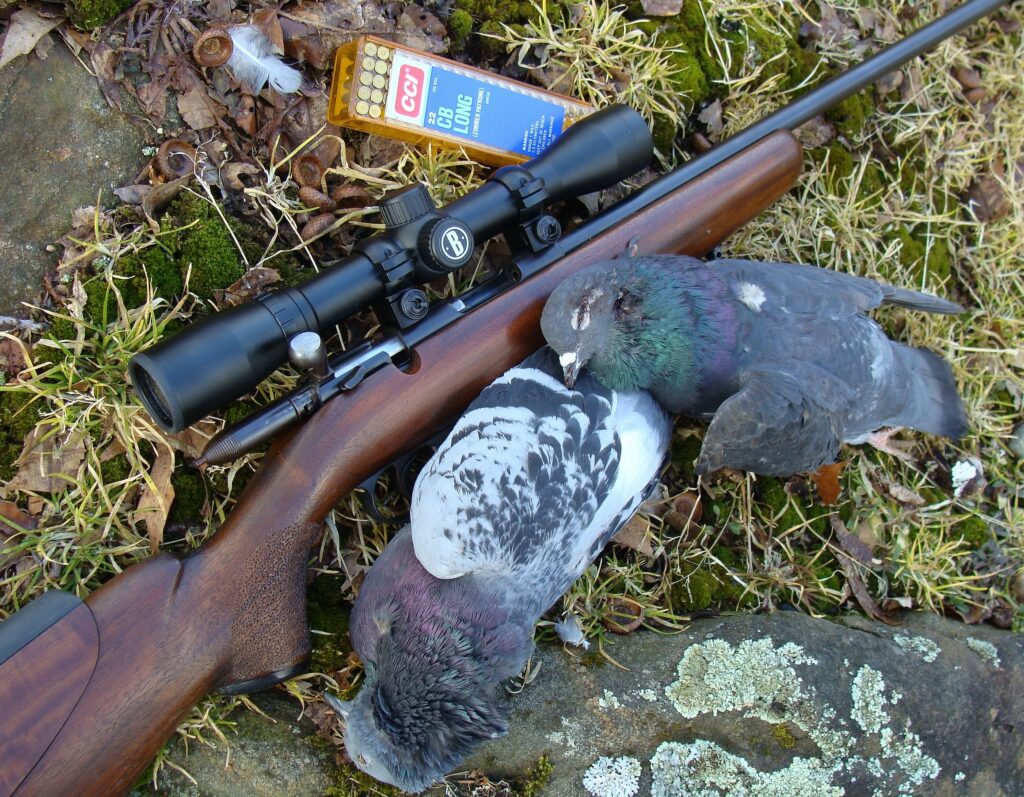
One repeating option is a Marlin tubular-magazine model, which can feed vast quantities of .22 Shorts or CBs (also true of most lever-actions and pumps). Most detachable magazine .22s won’t, but the stubby loads can usually be chambered by hand. Also, CCI’s .22 LR Quiets should feed in all bolt-actions. Beyond the Marlins, a number of decent and affordable picks exist, include Ruger’s Americans, CZs, those from Savage (also available in LH versions). There are also numerous used bolt-actions bargains lurking in most gun shops.
Advantages
Again, legal everywhere. Costs tend to be reasonable. Great load versatility. Ideal for small game or pests. Disassembly for cleaning is as simple as removing the bolt. Safe, too! Makes a good trainer for youngsters or anyone else. Match one to your centerfire if you can.
Disadvantages
No real defensive capability. LH models are less common. Same for parts (less critical when shooting at squirrels). Buy at least one extra magazine.
NUMBER FOUR – A Centerfire Bolt-Action Rifle
A bolt-action .308 makes the list, but not a heavy “sniper” version. Instead, I’ll take a sporter-weight rifle with plenty of good history. Remington’s M-700s and Savage 110s are two examples. Their flagship models exhibit good accuracy, and are accessory-friendly. Being bolt-guns, they’ll also cycle a large variety of loads including reduced-recoil types and special subsonics.
For big game, today’s homogeneous (solid-copper) hunting choices (like the 150-grain Barnes TSX) offer equivalent penetration to heavier jacketed bullets (165-180 grains) without increased recoil. Good chance a factory-configured sporter will shoot near-MOA; less than 5” at a quarter-mile. That’s quite a poke for field conditions with environmental factors thrown in. That was the logic behind Cooper’s Scout Rifle concept involving a short, handy .308 with a 10-round detachable magazine, and a low-magnification forward-mounted scope, backed up by iron sights.
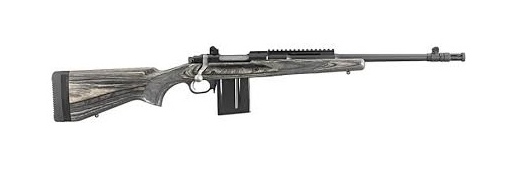
Today’s Ruger M-77 Scout Rifle, Savage 110 Scout, and Mossberg’s MVP fill this role nicely. Their threaded muzzles will accommodate a suppressor, and their receivers will accept conventional scopes. The recent ballistic-reticle types (like Leupold’s 2.5-8X Boone & Crockett) permit instant elevation and windage holds out to the quarter-mile mark, with no need for turret corrections.
Read: Centerfire Rifles: A Buyer’s and Shooter’s Guide by Steve Markwith
I often shoot much further using heavy-barreled, suppressed .308s, equipped with pricey large scopes but, even without a “can” attached, they’re so dang heavy I’ve yet to hunt with one. I’ve used Remingtons for years, most in standard sporting form; either M-700s, or more compact M-7s. Many Precision Rifle competitors trick out M-700s. Detachable-magazines are common but, after nearly losing one in the boonies, I’m back to self-contained hinged floor-plates. If starting from scratch, the Scout models are worth a look. Factor in weatherproof construction and LH availability.
Advantages
Uncomplicated, accurate, and easy to maintain by simply removing the bolt. Short-action rifles, designed for .308-length cartridges, are a tad more compact. This chambering offers adequate power for everything except intentional pursuit of giant bears, with the extra capability to feed milder loads – or surplus 7.62 NATO. Aftermarket items (stocks, triggers, scope mounts, etc.) abound for Remington M-700s, Savage 110s (and lately, Ruger Americans). The Ruger M-77, Savage 110, and Mossberg MVP scout versions are already good to go.
Disadvantages
Limited capacity for defensive purposes, and a slightly slower rate of fire. In a pinch though, a practiced shooter can make a bolt-gun sing like a pump-gun. Some worry about a Remington extractor but the only bad one I’ve seen was in brand new M-7 from their custom shop. A bigger concern for some could be LH operation and/or narrowed choices.
NUMBER FIVE – An AR-15
America’s Rifle is a bit underpowered for traditional big game including larger whitetail deer and black bear. Granted, some use it for this purpose, but most 5.56 NATO/.223 loads work better on varmints up to coyotes (or hogs, the goal being their eradication).
So, why not move up to an AR-10 in .308, eliminating the need for a bolt-gun? Well, you can, but most are God-awful heavy and carry more like truck axles. They’re also picky eaters and reliant on some proprietary parts.
Meanwhile, the smaller AR-15 will work for repelling invading hoards, or when covering ground on foot. Rumors to the contrary, the design is reliable. I bet my life on one for nearly two years and never had a stoppage. By that point early issues had been resolved. Regular (but not obsessive) cleaning, good magazines, and the right ammo did the trick. And, the relatively small 5.56 cartridges permitted a basic load of 300 rounds; reassuring in the bush. This advantage remains today, and the system has evolved for the better.
Many complaints actually relate to “custom builds” (translation: kitchen table), or iffy ammo and magazines. Fortunately, there are some good AR manufacturers. Several years ago, after an extensive T&E period, my agency sprung for 70 Windham Weaponry ARs. They were built to our specs as 16” carbines, similar to military (flat-top) M-4s, one difference being a Diamondback railed forend. Each wears an Aimpoint Pro (Patrol) dot-sight, backed up by a folding A.R.M.S. 40-L. Because battery life is phenomenal, we just leave our Aimpoints “on” and replace their batteries annually.
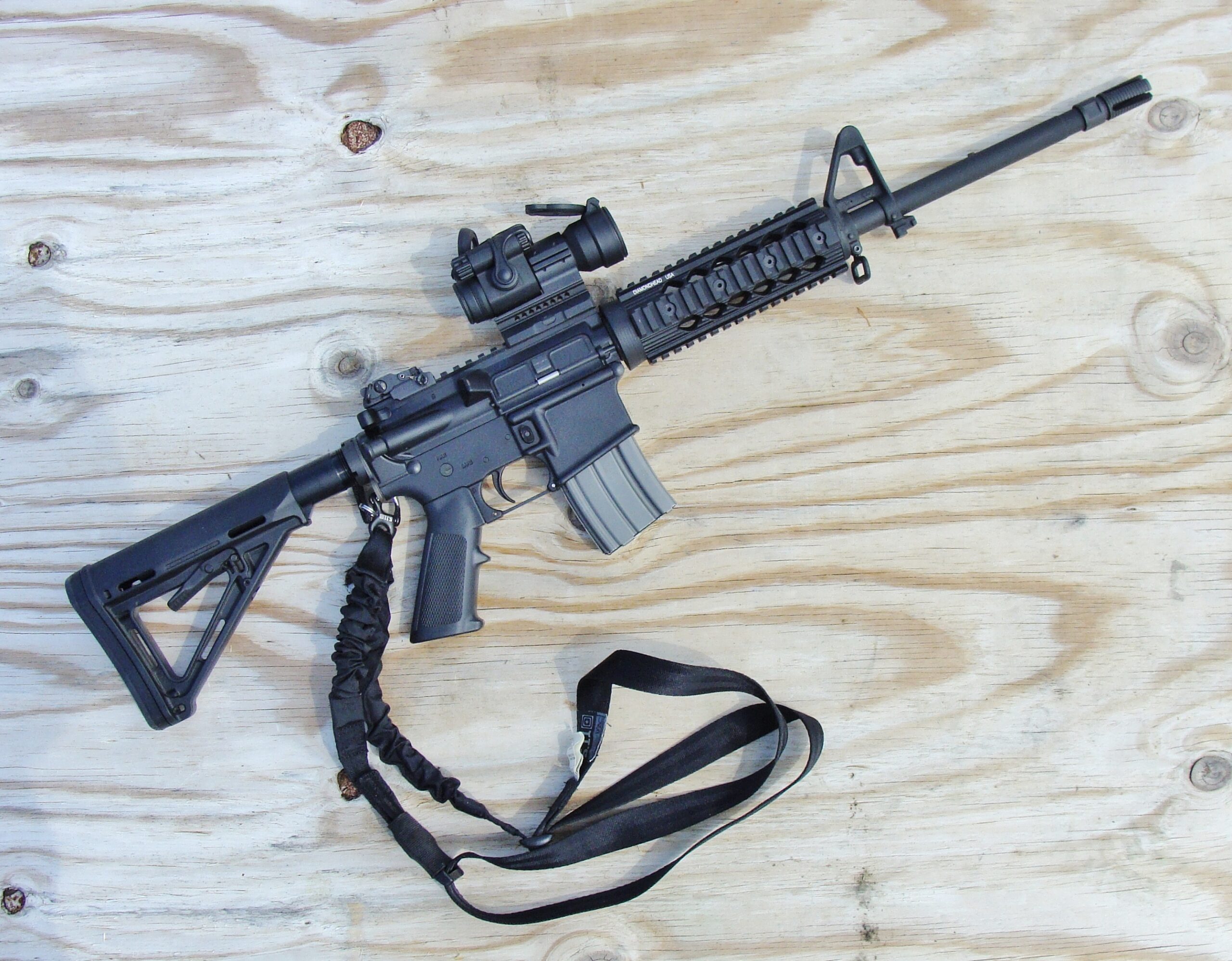
Although a low-magnification scope could be the better choice for some, we factored in shared use. Granted, carbine-configured ARs typically have telescoping stocks which can be adjusted for optimum eye-relief. However, a dot-sight eliminates that step entirely, along with any refocusing needs. The reticle also offers fast acquisition regardless of light conditions. Some of the new MRDS units are also effective, but we wanted a tubed type for use with weatherproof caps.
Today, our inventory is much larger. The original carbines now have fairly high round-counts but they still soldier on, despite less than gentle use. Among other good brands, I’ve had good luck with Rock Rivers.
Advantages
Adequate defensive power, plenty of capacity, and low recoil. A standard threaded-muzzle will accept suppressors or flash-hiders; important during low light. Ammo is affordable and abundant, along with parts. There’s a near-infinite assortment of accessories. Beyond easy mounting of optics, lights, etc. the entire platform can be modified to meet personal needs – or entirely reconfigured! Easy disassembly also supports proper maintenance.
Disadvantages
Legally restricted in some jurisdictions. Also, light for larger game. BUT, the AR is the ultimate transformer…
Caliber conversions: After manually retracting two captive pins, the complete upper receiver assembly can be separated, meaning it can also be exchanged for one in the popular .300 AAC Blackout (actually, this caliber only requires a different barrel – see converting a .223 to .300 Blackout). Viola! You gain an instant deer rifle, along with suppressed capability, depending on the load. I use .300 BLKTs both ways, enjoying great success. Oh, and you could also spring for a .22 LR upper. Stay tuned for future posts.
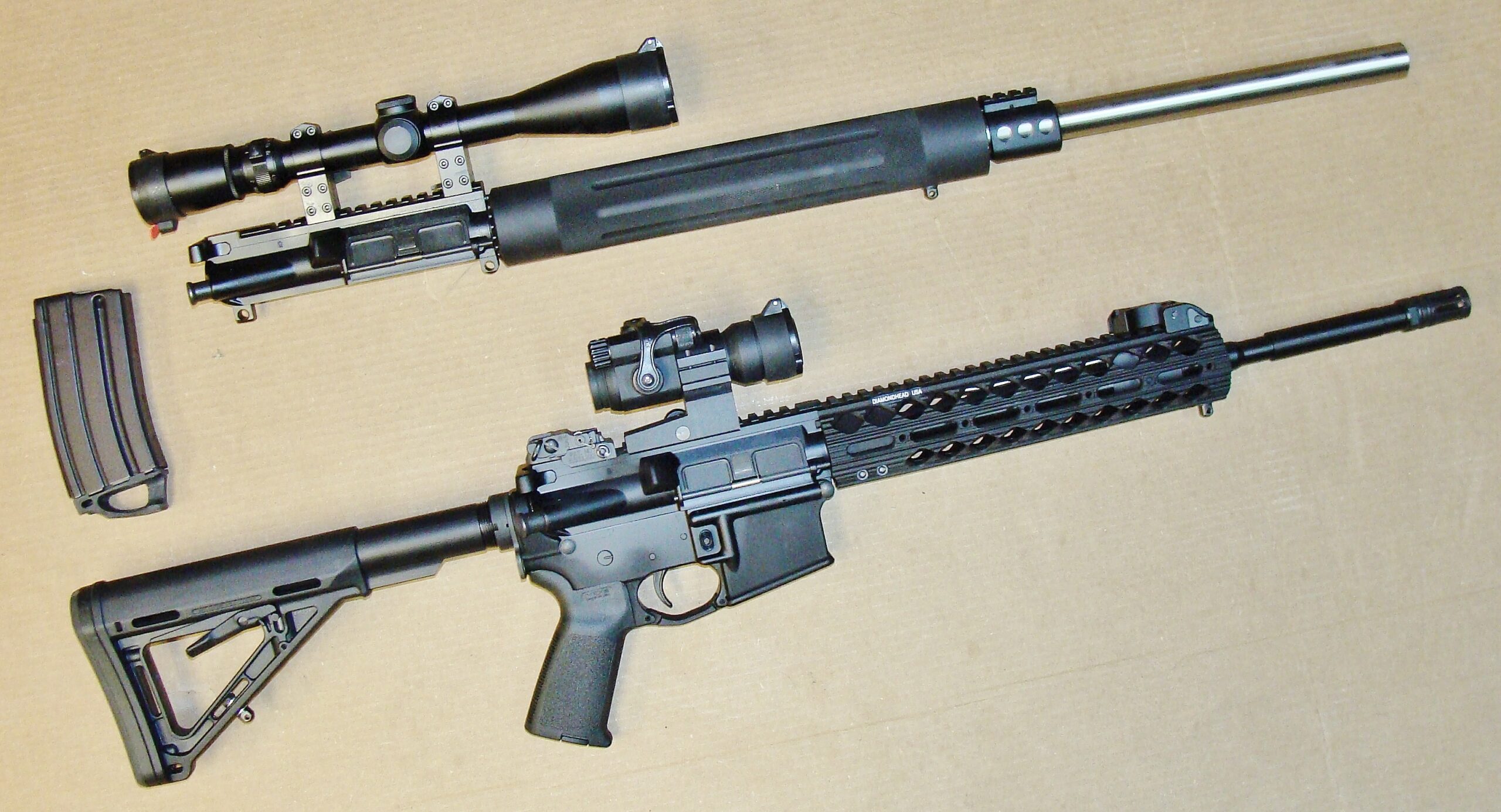
Closing Thoughts on Practical Long Guns
Well, that wraps up the shoulder-fired section. No doubt some will have entirely different favorites, in many cases, for legitimate reasons. That’s the beauty of America and our precious Second Amendment. Demand spawns innovation and competition, resulting in plenty of options – including some much better-suited for certain situations. A bandoleer of 5.56 magazines will matter less for someone in a wheelchair or leg-brace; and, although running a pump-gun with just one arm is possible, there are better choices.